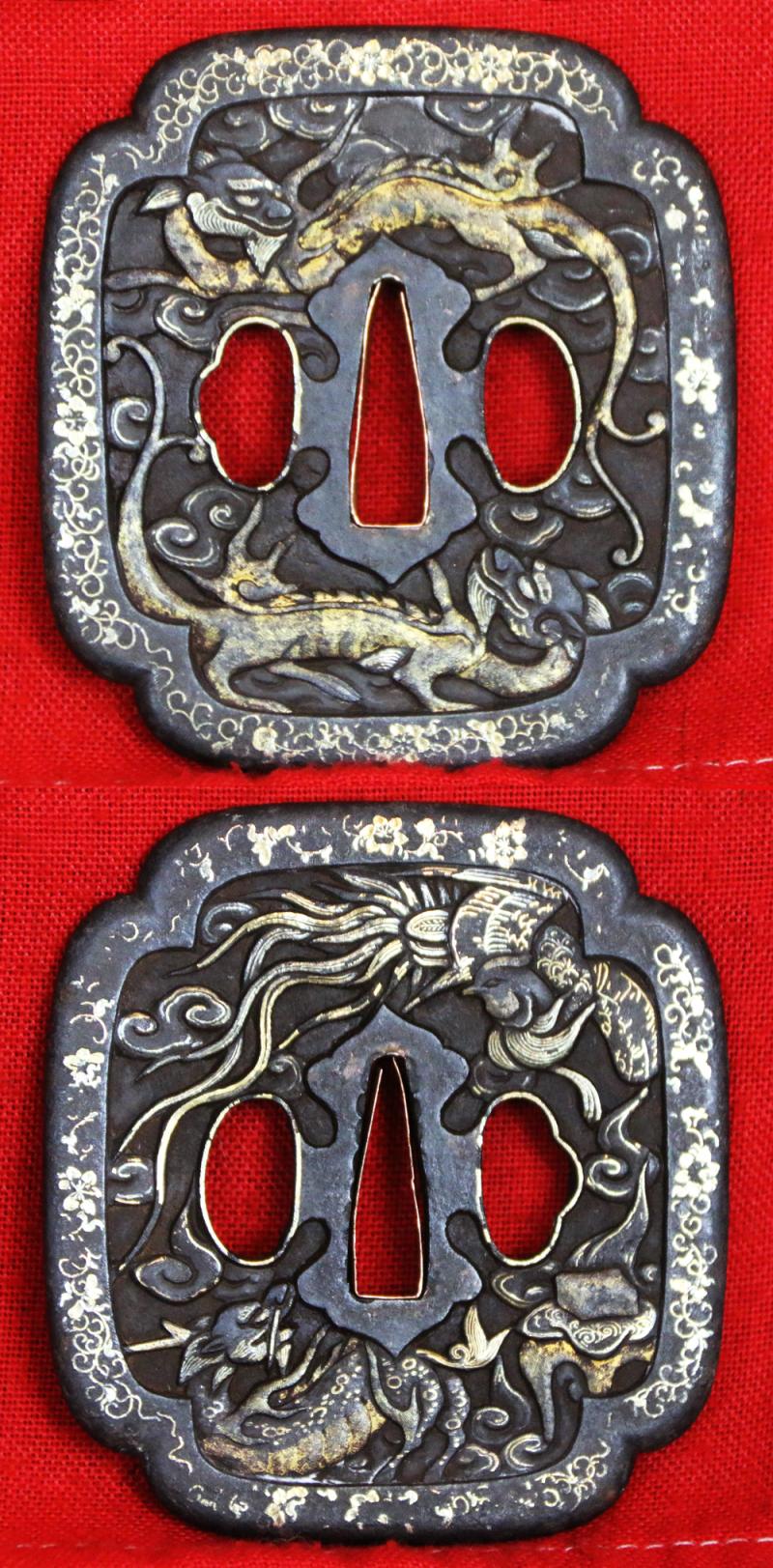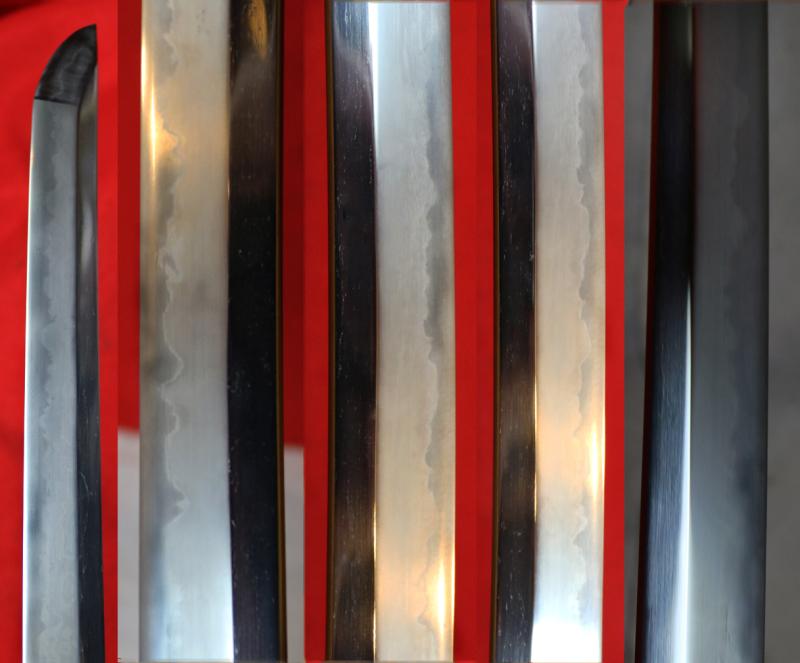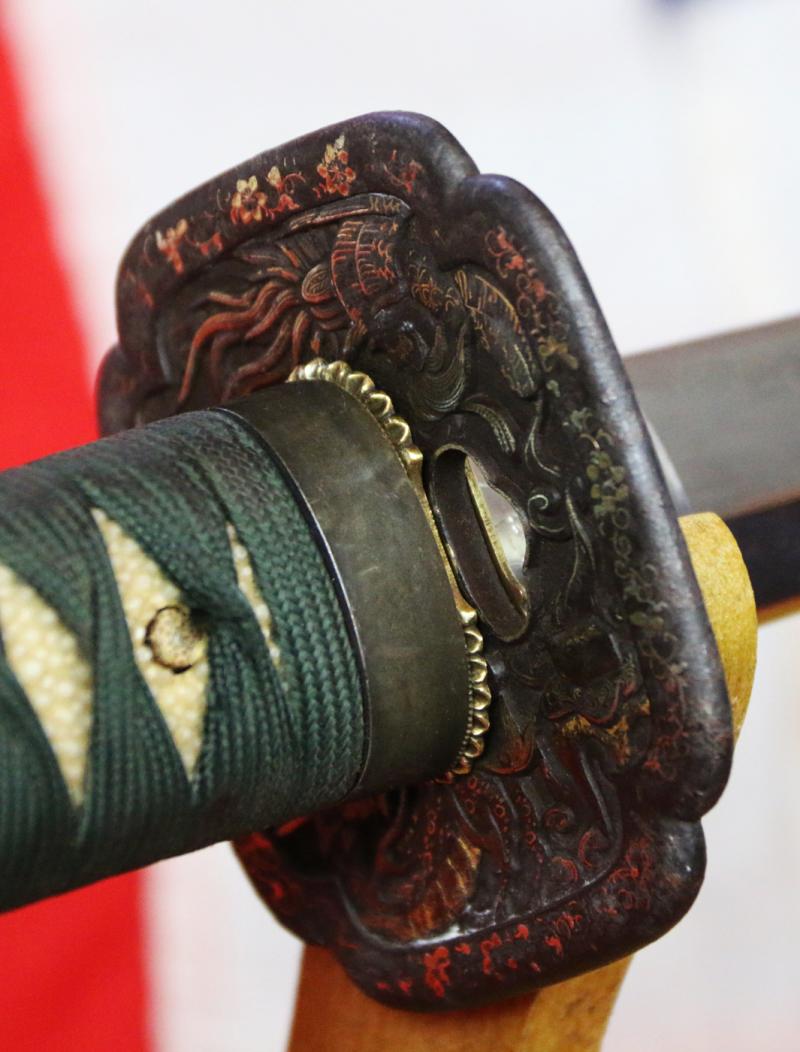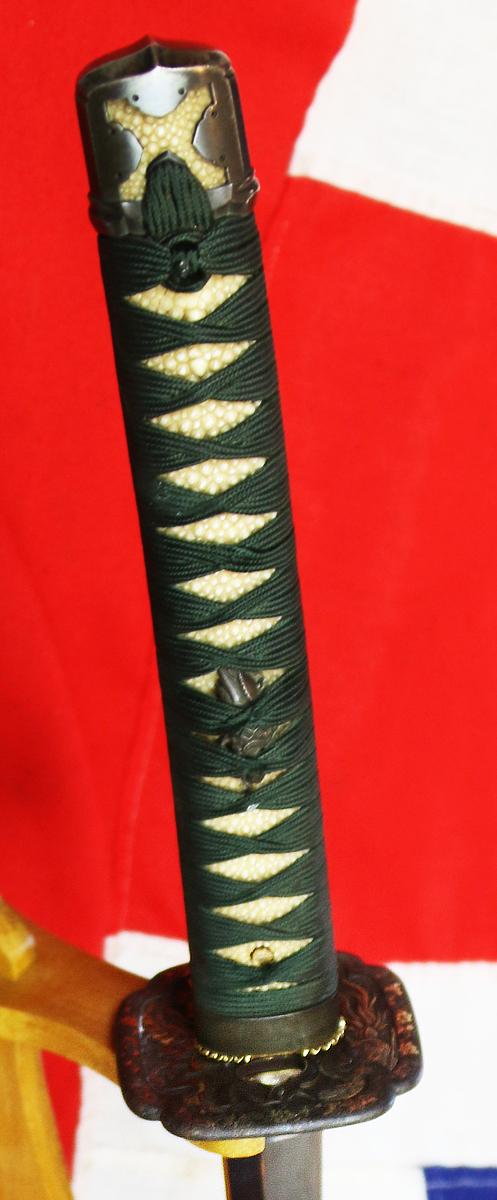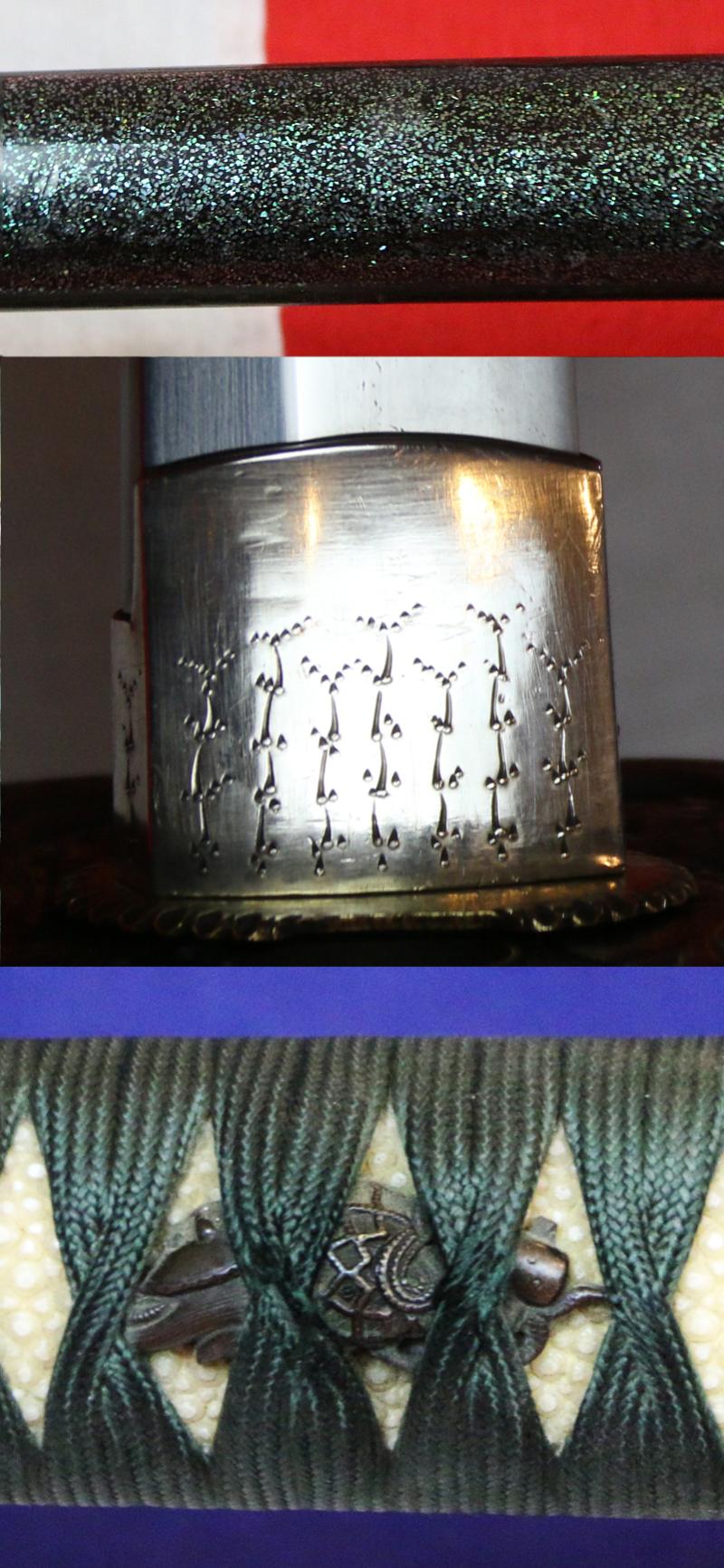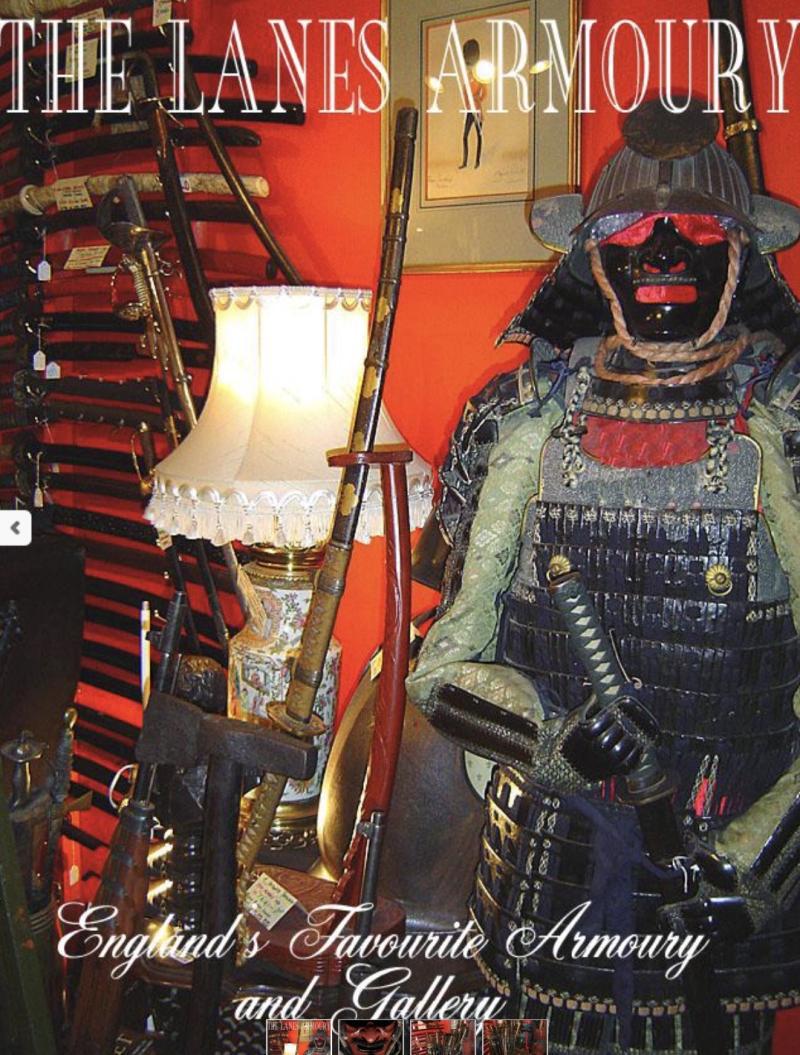A Stunning Kunitake Early Shinto Katana With All Original Very Fine Edo Period Koshirae & A Finest Quality Kagonami, Nanban, Kirin, Phoenix & Dragons Kiyou-Tojin Tsuba, Inlaid with Solid Silver and Gold, Nagasaki-he Gairaishita Chukokujin no Saku
Just one of the beautiful aspects of the Kunitake 国武 katana is its beautiful blade with a captivating hamon, in beautiful polish. All its stunning fittings are original early Edo including the original urushi lacquer saya with an irridescent twin panels of green ground of crushed abilone shell decor, bordered by black lacquer. Kabuto gane kashira in shakudo with matching shakudo fuchi, patinated copper menuki under original Edo tsuka-Ito of green silk to compliment the green urushi saya, and a wonderful Kiyou-Tojin Nanban Tsuba, a large rectangular sword guard. It has a stunning and very scarce form of habaki in silver with charming, engraved decor of various forms of raindrops, of a particular style that is very rare. The hamon shown on this beauty is absolutely beautiful and most complex.
The Swordsmith; signed Kunitake (国武), from the reign of Kan ́ei (寛永, 1624-1644), Yamashiro – “Heianjō-jū Fujiwara Kunitake” (平安城住藤原国武), “Kunitake” (国武), “Sanjō Kunitake” (三条国武), student of Horikawa Kunihiro (堀川国広), a later smith from the line of Sanjō Yoshinori (三条吉則), and tradition says that he was the father of Izumo no Daijō Yoshitake (出雲大掾吉武), often his blade forms are itame-nagare with ji-nie, suguha, notare mixed with gunome-ashi in ko-nie-deki, sugu-bōshi with a ko-maru-kaeri, wazamono, Rated as jō-saku {superior smith}
The magnificent tsuba is a tettsu {iron} plate with pure gold and silver wire inlay throughout. With twin carved takebori dragon to one side and the kirin and phoenix, to the opposite side, also takebori carved.
Japanese art often depicts the Kirin as deer-like, with an ox tail and a single horn, sometimes with a backwards-curving horn.
Significance:
The Kirin is believed to appear during periods of good governance and when a wise sage or ruler is present
Extremely similar in style and workmanship to a guard signed Zhūjiàn (珠見) or Shubai in Japanese.
Listed in Haynes H.08805.0 as an “artist from China” ca. 1650-1700.
Yoshimura Shigeta illustrates a similar piece in his book Nanban Tsuba, page 10.
The caption reads, Nagasaki-he gairaishita Chukokujin no saku or
"Said to be made by a Chinaman who came to Nagasaki"
The manner of execution of the tsuba represents a very high degree of artistic hybridity, suggesting that the tsuba was made along maritime trade-routes, where artisans had access to decorative arts from around the globe. The indented corners, pointed Shitogi-gata seppa-dai, smooth-skinned dragons and phoenix in takebori style and almost caricature drawing- style, points to Indochina, perhaps Tonkin. There is a similar piece in the 1973 W.M. Hawley book Tsubas (sic) in Southern California. One can see a number of similar pieces with NBTHK attribution to "Nagasaki". Although some believe it more likely is that these were imported to Japan through the VOC factory in Deshima.
Cultural exchanges between China and Nagasaki became quite frequent after the Kangxi emperor reopened Qing seaports to foreign trade in 1684, and issued trading licenses to private concerns.In the 1640s a number of refugees from the collapse of the Ming Dynasty emigrated to Nagasaki. One of them—Shoyu Itsunen became the abbot of Kofukuji temple in Nagasaki. Itsunen is also known to have taught painting to Kawamura Fukuyoshi, a samurai and customs official who is better known as Jakushi I. Another Chinese priest, Yinyuan Lonqi, was the abbot of Wanfu temple on Mount Huangbo in Fujian. He came to Nagasaki at the invitation of Itsunen. Lonqi, known in Japan as Ingen Ryuki, became the founder of Obaku Zen Buddhism. The Nagasaki school of painting was deeply influenced by the Chinese painter Shen Nanpin, who lived and taught painting in Nagasaki for several years. Nanpin’s work was heavily influenced by European scientific and botanical painting, which resonated with the intellectual community at Nagasaki, which in Japan was the centre of Chinese medical studies, and Rangaku (the study of European science).
Nanban-style tsubas (Japanese sword guards) often feature intricate designs incorporating dragons and phoenixes. These designs, commonly found in Hizen ware during the Edo period, represent the harmonious union of opposites – the masculine dragon and the feminine phoenix. This symbolic representation reflects the balance between power and grace, often associated with the Emperor and Empress in Japanese culture.
Key aspects of Nanban tsubas with dragon and phoenix:
Symbolism:
The dragon represents strength and power, while the phoenix embodies grace and beauty. Together, they symbolize the harmonious union of opposites.
Design:
Nanban tsubas often feature intricate designs with dragons, phoenixes, and other floral motifs, sometimes incorporating techniques like pierced work, inlays, and gilding. This is a sublime example of just such workmanship
Influence:
Nanban style was influenced by foreign art and culture, particularly Chinese designs, which contributed to the prevalence of dragons and phoenixes in these tsubas.
Examples:
The Ashmolean Museum has examples of Nanban tsubas with these designs.
Nanban tsubas are typically made of iron and often feature intricate details in gold or silver as does this example.
THE LANES ARMOURY, THE PREMIER HOME OF ORIGINAL AND AFFORDABLE ANCIENT ANTIQUITIES & ANTIQUE COLLECTABLES IN BRITAIN.
The Lanes Armoury, is world renown as Britain's favourite specialist collectors shop, and also a font of historical and educational information that is detailed with every single item. We detail each piece alongside its historical context, either generic or specific, for those that may wish to read, learn, or be informed, as opposed to simply acquire collectable items. We are probably one of the oldest companies of our kind in the whole of Europe and we have been established through generations, as specialists in armoury, military antiques, militaria collectables, and specialist books, since the early 1900’s, and thus we have continued to be one of the largest in the world today. The current partners were set on this path by their great grandfather, who while intrigued by historic antique arms and armour, was woefully under capitalised for his dream profession, so much so that even when starting his very small business, just after the first world war, he still kept up his original working class pre war trade as a scaffolder as his safety net in case his dreams folded. Just as well for his succeeding generations, he didn’t fail. However, true to his very old-fashioned working class ethics, every subsequent generation had to follow their own path, with no financial assistance whatsoever, with his son, grandson and great-grandsons having to make their own way, on their own skill and merits, whatever they may be.
We are also very pleased to know we are also studied and read by academics and students from hundreds of universities around the world, by those that are interested in not only British but worldwide history. Of course we are not perfect and errors can and will be made, but thanks to our viewers and visitors, errors can be corrected, and learnt from.
Our sacred principle is that every single country's history ought to be studied, and passed down, however good, or bad some of it may be. All history is knowledge, good, bad or indifferent.
Everyday we are contacted by historians that wish to make contributions to our detailed information for our pieces, and to thus add to our constant dedication to impart historical knowledge, that may be unknown to many of our millions of viewers.
As once told to us by an esteemed regular visitor to us here in our gallery, in order to view and study our Japanese edged weapons and armour gallery, and the same words that are repeated in his book;
“In these textures lies an extraordinary and unique feature of the sword - the steel itself possesses an intrinsic beauty. The Japanese sword has been appreciated as an art object since its perfection some time during the tenth century AD. Fine swords have been more highly prized than lands or riches, those of superior quality being handed down from generation to generation. In fact, many well-documented swords, whose blades are signed by their makers, survive from nearly a thousand years ago. Recognizable features of the blades of hundreds of schools of sword-making have been punctiliously recorded, and the study of the sword is a guide to the flow of Japanese history.”
Victor Harris
Curator, Assistant Keeper and then Keeper (1998-2003) of the Department of Japanese Antiquities at the British Museum. He studied from 1968-71 under Sato Kenzan, Tokyo National Museum and Society for the Preservation of Japanese Swords
Code: 25789
9360.00 GBP



